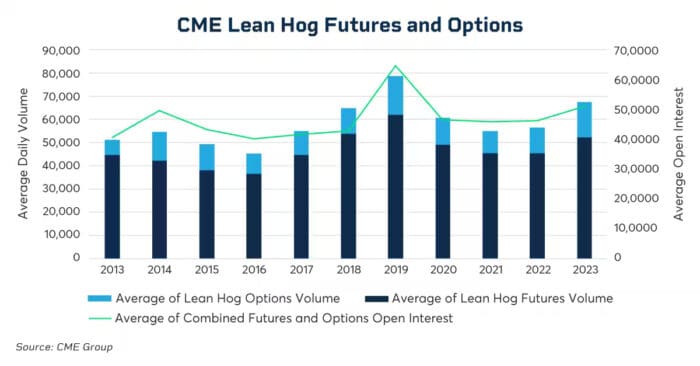AT A GLANCE
- Higher input costs and a stout supply have helped create what could be the worst ever two-year stretch for profitability in U.S. hog production
- Domestic demand for pork has remained flat, while China, traditionally one of the largest importers of U.S. pork, has increased its domestic supply
It’s been a difficult year for the pork industry as several factors conspire to challenge producers and processors.
CME Lean Hog prices hover at near three-year lows, with values holding around $71 per hundredweight (cwt), about $5/cwt higher than recent lows. Lee Schulz, extension economist at Iowa State University says the university’s Estimated Livestock Returns model forecasts pork producers are likely to experience a $32 per head loss in 2023. If conditions don’t change, Schulz says Iowa State’s model projects an $18 per head loss for 2024.
“If realized, 2023 and 2024 will go down as the worst two-year stretch for profitability in hog production, even eclipsing the infamous losses in 1998 and 1999. But profits will eventually return to the pork industry,” he wrote in an October blog post.
Trish Cook, president of the Iowa Pork Producers and a producer with a farrow-to-finish operation in eastern Iowa, feels these struggles personally.
“The economic challenges have been really, really, hard in our industry,” she says.
Don Close, chief research and analytics officer at Terrain Ag, says the financial losses hog producers face are also extending to the pork processors. In April, Tyson closed a Nebraska pork plant following a fire, and Smithfield announced it was closing its Charlotte, N.C. pork-processing plant. Earlier this year the processor said it was closing nearly 40 farms in Missouri.
“Both the product producers and the processors are being squeezed at the same time,” he says.
As profitability declines and challenges mount, trading in CME Lean Hog futures has climbed to its highest level since 2019 when African Swine Fever impacted markets. Both trading volume and open interest – the number of unsettled contracts – have surged as market participants manage price risk.

Input Costs Weigh on Margins as Supplies Remain High
Animal feed and running facilities are two of the biggest costs for pork producers, Cook says. CBOT corn prices traded over $6.50 a bushel in the spring and soybean prices topped $16 a bushel this summer. Those prices have retreated by 30% for corn and 20% for soybeans, which will help take some of the sting out of weaker margins. Cook notes that liquid propane costs are down from a year ago, making it less costly to heat hog barns, which will also help.
The drop in feed grain prices is bringing some relief, but the impact is limited, says David Weaber, senior research analyst at Terrain Ag. “The price for livestock is still so depressed, that it’s minimizing losses, not getting us back to any kind of profitability,” he adds.
Although hog values are weak, animal supplies are still stout. The U.S. Department of Agriculture’s September Hogs and Pigs Report showed hog numbers increased slightly. There are 74.3 million hogs and pigs on U.S. farms, up 2% from June and marginally higher than a year ago. From June to August, pork producers weaned an average 11.6 pigs per litter, and producers intend to have 2.94 million sows farrow between September and November, with plans to slightly decrease that number to 2.91 million from December to February 2024.
As a farrow-to-finish producer, Cook says she hasn’t adjusted production in light of weaker prices. “A lot of times in this industry, it’s not like you hop in and out. You’ve got facilities; you have a fixed cost in that facility,” she says.
With input costs easing and expectations that hog numbers will begin to taper off, she’s looking ahead to next year for what she hopes will be better times.
“We are really hoping that in mid-2024 we’ll see profits,” she says.
Sluggish Demand
Pork demand languished all year long, even during summer months when grilling-friendly cuts like ribs become popular. Weaker prices normally should stoke consumer demand, but Weaber says whether the currently low prices translate to a consumption pick up in 2024 remains to be seen.
“If you look at where we’re at, from a price standpoint, relative to chicken and beef, I’m worried that pork might not get it done,” he says.
Sluggish U.S. consumer pork demand is not just a seasonal problem, Close and Weaber say. It’s a structural problem that’s been developing for years. Pork consumption holds around 50 to 52 pounds annually, regardless of what’s going on in the industry, they say.
Changing consumer taste and preferences are behind flat domestic demand, Close says. Traditionally, pork loins were considered the prime product on hogs, but that’s been inverted to where bellies and hams are the big sellers, which created these structural challenges.
If the industry wants to move more pork, it needs to look overseas. “At this point, if I were a packer or processor, I would be solely focused on trying to figure out how to export more product, because I don’t see that we’re going to get U.S. consumers to move,” Weaber says.
Exports to Asia declined in 2023, with a stronger U.S. dollar and competition from other providers, Weaber says. China has improved its domestic pork supply, and Brazil is stepping up as a low-cost competitor, pushing out the U.S. Meanwhile, demand from South Korea and Japan has been fair, while Mexico has become a bigger consumer.
Impact of Proposition 12
California’s Prop 12 law has exacerbated the economic challenges in the pork industry and created greater uncertainty, the sources say. The regulations, which went into effect this year, require veal calves, breeding pigs and egg-laying hens to be housed in systems with specific size standards. Producers who want to sell pork in California’s market will need to certify they align with Prop 12’s requirements.
Weaber says so far California consumers have not stepped up their buying of Prop 12-compliant pork. He says packers who have Prop-12 compliant pork available for sale on a weekly basis are seeing meat go unsold. “There’s been a pretty significant impact on California consumer willingness to participate in the product,” he says.
Higher costs may be behind the reluctance to buy pork. For example, pork loin prices are up about $1.50 to $2 a pound compared to non-Prop 12 compliant pork, he says. “When consumers look at that, they may say, ‘is beef that much further out of reach? Or do we buy premium chicken’,” he says.
—
Originally Posed December 5, 2023 – Weak Demand and Hefty Supplies Continue to Weigh on Hog Markets
Disclosure: CME Group
© [2023] CME Group Inc. All rights reserved. This information is reproduced by permission of CME Group Inc. and its affiliates under license. CME Group Inc. and its affiliates accept no liability or responsibility for the information contained herein, including but not limited to the currency, accuracy and/or completeness of this information, and delays, interruptions, errors or omissions. This information is an unofficial copy and may not reflect the official and accurate version. For the definitive and up-to-date version of any of this information, please see cmegroup.com.
Disclosure: Interactive Brokers Third Party
Information posted on IBKR Campus that is provided by third-parties does NOT constitute a recommendation that you should contract for the services of that third party. Third-party participants who contribute to IBKR Campus are independent of Interactive Brokers and Interactive Brokers does not make any representations or warranties concerning the services offered, their past or future performance, or the accuracy of the information provided by the third party. Past performance is no guarantee of future results.
This material is from CME Group and is being posted with its permission. The views expressed in this material are solely those of the author and/or CME Group and Interactive Brokers is not endorsing or recommending any investment or trading discussed in the material. This material is not and should not be construed as an offer to buy or sell any security. It should not be construed as research or investment advice or a recommendation to buy, sell or hold any security or commodity. This material does not and is not intended to take into account the particular financial conditions, investment objectives or requirements of individual customers. Before acting on this material, you should consider whether it is suitable for your particular circumstances and, as necessary, seek professional advice.
Disclosure: Futures Trading
Futures are not suitable for all investors. The amount you may lose may be greater than your initial investment. Before trading futures, please read the CFTC Risk Disclosure. A copy and additional information are available at ibkr.com.



















Join The Conversation
For specific platform feedback and suggestions, please submit it directly to our team using these instructions.
If you have an account-specific question or concern, please reach out to Client Services.
We encourage you to look through our FAQs before posting. Your question may already be covered!